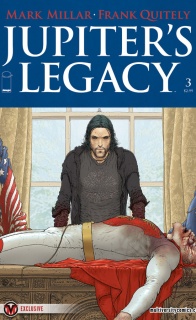After a slow build in the previous two issues, Mark Millar and Frank Quitely kick down not just the door, but the entire house in the latest issue of “Jupiter’s Legacy.”

Written by Mark Millar
Illustrated by Frank QuitelyThe heroes conspire to overthrow The Utopian, discontent rumbling in the bars and the clubs where the superheroes get wasted and complain how much he’s been holding them all back with his old-fashioned ideas of power and responsibility. There’s a new world out there if they will only grasp it. But what is his daughter’s secret and how will it change things forever for their family?
In my review, of “Jupiter’s Legacy” #2, I questioned the validity of the solicitation text’s jab at Superman. What was likely just marketing hype in the midst of Man of Steel, prompted a discussion on what we look for in superhero comics. In a time when comics are starting to feel “fun” again, do we really need more superhero deconstruction?
It was, and still is, very easy to chalk “Jupiter’s Legacy” up as just another “Watchmen” by-product. It certainly shares several sensibilities of that seminal series, with a good bit of “The Authority” (which, ironically, Millar and Quitely previously collaborated on) thrown in for good measure. Despite its seemingly derivative nature, however, “Jupiter’s Legacy” has a lot setting it apart from those stories.
I’ll admit, I was perhaps a bit unfair in my review of issue #2. When it comes to reviewing serialized stories, it becomes extremely difficult to gauge a single 20-odd page issue in a vacuum. As comic fans, we have come to expect a certain structure, a certain order to the way stories are told. It becomes common place for first issues to grab readers with shock and awe tactics. Not to necessarily accuse Millar of such tactics, but works like “Kick-Ass” and “Nemesis” have certainly built up a kind of “expectation” for his work.
In this way, Millar played a risky game by going against his usual bombastic style, making the first two issues of “Jupiter’s Legacy,” fairly light. He focuses on building the world and its principal characters, rather than shock value. As it turns out, the third issue has all the hooks and jaw dropping moments you might expect from a Millar penned #1. However, by playing the long con, Millar has infused the ongoing stories of the Utopian and his family with an incredible amount of emotion. When viewed as the culmination of the story thus far, issue #3 validates everything that has come before.
When you strip away its bright costumes and political trappings, the central theme of “Jupiter’s Legacy” #3 is family. The power struggle between brothers, the son who yearns for his father’s respect and approval, the flawed father who only wants what’s best for his family, these are all concepts that resonate with us. These scenarios, and the emotions they dredge up, make what Millar does here all the more gut-wrenching.
This issue is, unabashedly, Breaking Bad brutal. While issue #2 pretty well laid out what was going to happen here, no one could’ve expected Millar to go quite as far as he does here. Spoilers: People die in this issue, quite brutally, and no one has ever made it look quite so visceral as artist Frank Quitely. We get reprises of several visual cues and motifs from the first issue, cast in a much more sinister light. It’s nearly impossible to discuss what Quitely does here in great detail, because to describe any scene in such detail would risk spoiling things that need not be spoiled. Suffice to say; “Jupiter’s Legacy” is quickly shaping up to be the artist’s finest works. If you’re familiar with his work, then you know that is truly saying something. If not, then you are truly in for a treat.
By issues’ end, Millar and Quitely have drastically changed the landscape in which this world operates. The lines are drawn, power balances shift, with some heroes rising and others on the run for their lives. The original title of “Jupiter’s Children” takes on a new significance.
Now that the story has begun in earnest, Millar promises a shift into the future, wherein the consequences will be immediately felt. He also teases a glimpse into the past, and suggests some answers the mysterious island in the first issue. What began a seemingly derivative book has quickly developed a strong cast, an engaging mythology, and that oh so elusive hook that has ensured that at least one reader will be coming back for more.
Final Verdict: 9.5 – Buy.



